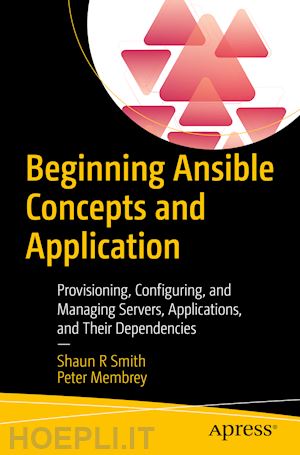

Questo prodotto usufruisce delle SPEDIZIONI GRATIS
selezionando l'opzione Corriere Veloce in fase di ordine.
Pagabile anche con Carta della cultura giovani e del merito, 18App Bonus Cultura e Carta del Docente
Learn the concepts and develop the skills to be a true Ansible artist and use it inside and outside the box. This book applies key concepts immediately while building up your Ansible skills layer by layer through easy to grasp examples and engaging projects. You’ll also think about security, why testing is important, and how to use version control safely.
As a beginner to Ansible, you'll be guided step-by-step through creating your first Ansible playbook to deploying your first server and writing more complex cross-dependency playbooks. From the first line of code to the last, you'll constantly iterate and simplify your playbooks, iwhile taking on more complex topics as you construct a full Wordpress website stack consisting of a database, web servers, and load balancer. This book will prompt you to think about how these fit together and will explain what to do to ensure maintainability long into the future.
Don’t just use Ansible. Completely change how you go about provisioning, configuring, and managing servers, applications, and their dependencies with this powerful, open source automation tool. In exchange for this power and efficiency, Ansible demands a very different way of thinking about resources and how they all fit together. This can be hard to get your head around if you’ve never done it before. Every step of the way, Beginning Ansible Concepts and Application show you best practices so that you can confidently start using Ansible right away.
What You'll Learn
Who This Book Is For
Developers looking for a better way to manage their servers other than by logging in and typing commands. Also enthusiasts whowant to learn not just how to use Ansible but how to use it correctly and confidently.











Il sito utilizza cookie ed altri strumenti di tracciamento che raccolgono informazioni dal dispositivo dell’utente. Oltre ai cookie tecnici ed analitici aggregati, strettamente necessari per il funzionamento di questo sito web, previo consenso dell’utente possono essere installati cookie di profilazione e marketing e cookie dei social media. Cliccando su “Accetto tutti i cookie” saranno attivate tutte le categorie di cookie. Per accettare solo deterninate categorie di cookie, cliccare invece su “Impostazioni cookie”. Chiudendo il banner o continuando a navigare saranno installati solo cookie tecnici. Per maggiori dettagli, consultare la Cookie Policy.